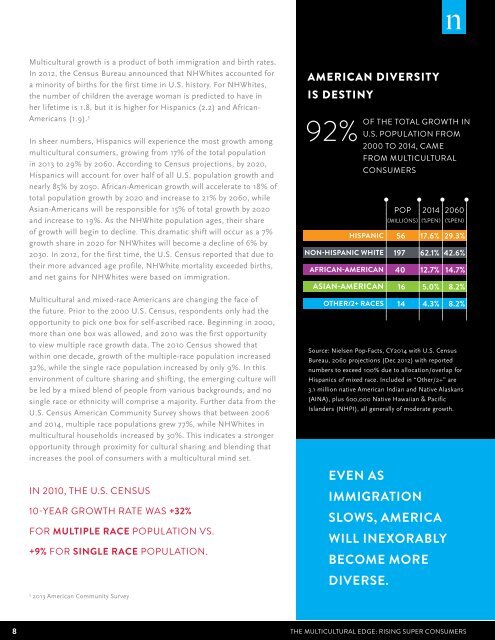the-multicultural-edge-rising-super-consumers-march-2015
the-multicultural-edge-rising-super-consumers-march-2015
the-multicultural-edge-rising-super-consumers-march-2015
Create successful ePaper yourself
Turn your PDF publications into a flip-book with our unique Google optimized e-Paper software.
Multicultural growth is a product of both immigration and birth rates.<br />
In 2012, <strong>the</strong> Census Bureau announced that NHWhites accounted for<br />
a minority of births for <strong>the</strong> first time in U.S. history. For NHWhites,<br />
<strong>the</strong> number of children <strong>the</strong> average woman is predicted to have in<br />
her lifetime is 1.8, but it is higher for Hispanics (2.2) and African-<br />
Americans (1.9). 3<br />
In sheer numbers, Hispanics will experience <strong>the</strong> most growth among<br />
<strong>multicultural</strong> <strong>consumers</strong>, growing from 17% of <strong>the</strong> total population<br />
in 2013 to 29% by 2060. According to Census projections, by 2020,<br />
Hispanics will account for over half of all U.S. population growth and<br />
nearly 85% by 2050. African-American growth will accelerate to 18% of<br />
total population growth by 2020 and increase to 21% by 2060, while<br />
Asian-Americans will be responsible for 15% of total growth by 2020<br />
and increase to 19%. As <strong>the</strong> NHWhite population ages, <strong>the</strong>ir share<br />
of growth will begin to decline. This dramatic shift will occur as a 7%<br />
growth share in 2020 for NHWhites will become a decline of 6% by<br />
2030. In 2012, for <strong>the</strong> first time, <strong>the</strong> U.S. Census reported that due to<br />
<strong>the</strong>ir more advanced age profile, NHWhite mortality exceeded births,<br />
and net gains for NHWhites were based on immigration.<br />
Multicultural and mixed-race Americans are changing <strong>the</strong> face of<br />
<strong>the</strong> future. Prior to <strong>the</strong> 2000 U.S. Census, respondents only had <strong>the</strong><br />
opportunity to pick one box for self-ascribed race. Beginning in 2000,<br />
more than one box was allowed, and 2010 was <strong>the</strong> first opportunity<br />
to view multiple race growth data. The 2010 Census showed that<br />
within one decade, growth of <strong>the</strong> multiple-race population increased<br />
32%, while <strong>the</strong> single race population increased by only 9%. In this<br />
environment of culture sharing and shifting, <strong>the</strong> emerging culture will<br />
be led by a mixed blend of people from various backgrounds, and no<br />
single race or ethnicity will comprise a majority. Fur<strong>the</strong>r data from <strong>the</strong><br />
U.S. Census American Community Survey shows that between 2006<br />
and 2014, multiple race populations grew 77%, while NHWhites in<br />
<strong>multicultural</strong> households increased by 30%. This indicates a stronger<br />
opportunity through proximity for cultural sharing and blending that<br />
increases <strong>the</strong> pool of <strong>consumers</strong> with a <strong>multicultural</strong> mind set.<br />
In 2010, <strong>the</strong> U.S. Census<br />
10-year growth rate was +32%<br />
for Multiple Race population vs.<br />
+9% for Single Race population.<br />
American Diversity<br />
is Destiny<br />
92%<br />
of <strong>the</strong> total growth in<br />
U.S. POPULATION from<br />
2000 to 2014, came<br />
from <strong>multicultural</strong><br />
<strong>consumers</strong><br />
Pop 2014 2060<br />
(millions) (%Pen) (%Pen)<br />
Hispanic<br />
NON-HISPANIC WHITE<br />
African-American<br />
Asian-American<br />
O<strong>the</strong>r/2+ Races<br />
56<br />
197<br />
40<br />
16<br />
14<br />
17.6%<br />
62.1%<br />
12.7%<br />
5.0%<br />
4.3%<br />
29.3%<br />
42.6%<br />
14.7%<br />
8.2%<br />
8.2%<br />
Source: Nielsen Pop-Facts, CY2014 with U.S. Census<br />
Bureau, 2060 projections (Dec 2012) with reported<br />
numbers to exceed 100% due to allocation/overlap for<br />
Hispanics of mixed race. Included in “O<strong>the</strong>r/2+” are<br />
3.1 million native American Indian and Native Alaskans<br />
(AINA), plus 600,000 Native Hawaiian & Pacific<br />
Islanders (NHPI), all generally of moderate growth.<br />
Even as<br />
immigration<br />
slows, America<br />
will inexorably<br />
become more<br />
diverse.<br />
3<br />
2013 American Community Survey<br />
8<br />
THE MULTICULTURAL EDGE: RISING SUPER CONSUMERS


